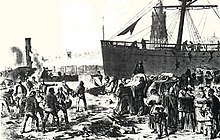Alexander Keith Jr.
Alexander 'Sandy' Keith, Jr. (1827–1875) was a notorious nineteenth-century criminal from Halifax, NS, Canada. He invented and used the time bomb for criminal purposes.

Life and career
Keith was born in 1827 in Caithness, Scotland, immigrating to Halifax when he was a small boy. The nephew of Alexander Keith, founder of the Alexander Keith's brewery, Keith worked for a time as a clerk in his uncle's brewery.
Keith became a secret agent for the Confederate States of America during the American Civil War, acting mostly as a blockade runner and courier. Keith assisted in helping Confederate sympathisers escape justice in the Chesapeake Affair. He was also involved with Luke Blackburn in an infamous plot to send clothes infected with yellow fever to northern cities in the United States.[1]
In 1865, he swindled his associates-in-crime and fled to St. Louis, Missouri, settling finally on the prairie. There, he married Cecelia Paris, a milliner's daughter from St. Louis.
Bremerhaven: attack on the Mosel

Hunted down by one of his victims, Keith fled again with Cecelia to Germany, where they lived the high life in Dresden and Leipzig, hobnobbing with wealthy socialites and Saxon generals under the assumed name of "William King Thomas". When the couple began to run out of money, Keith concocted a plot to blow up passenger ships and collect the insurance money. This led to a major catastrophe in Bremerhaven, on December 11, 1875 when a time bomb he had placed in a shipping barrel accidentally went off on the dock, killing eighty people, most of them aboard the steamship Mosel, a German emigrant ship. She was under the command of Captain Leist, replacement for the ailing captain Hermann Neynaber for a crossing to New York. The passengers were on board and the final baggage was being loaded. With only a few large shipping crates on the pier, one of Keith's barrels slipped out the stevedores' hands while being loaded and struck the ground, exploding in a huge column of fire whose blast caused two ships at the quay to overturn. It was recorded by one witness: "A mushroom-shaped column of smoke rose approximately 200 meters above the harbor. Everywhere people were crying and whimpering beside ruins. The entire pier was covered in soot: it was like the gateway to hell." At the time, the deed was called the "crime of the century."
Death and legacy
Keith was aboard another ship in Bremerhaven at the time of the Mosel explosion, and was thus aware of the premature detonation of his time bomb and the massive carnage that ensued. He went to his suite and shot himself. He died a week later. After the tragedy was revealed as a murder/insurance scam on a large scale, the disappearances of other ships were investigated to see if Keith and his possible associates were involved. One was the disappearance of the SS City of Boston which vanished in January 1870. The allegation was proven to be false.[2] He was reputed to have been buried in an unmarked grave in Bremerhaven. His severed head was kept at the Bremer Police Museum and was destroyed by Allied bombing in 1945.
Keith himself was not a terrorist, but his invention of the time bomb inspired modern terrorism, notably by the Fenians (Irish Brotherhood) and the Russian Narodnaya Volya. Says Keith's biographer Ann Larabee: "Keith was not responsible for the political passion of these violent political groups, but he played a role in showing them a means of action."[3]
Opera
Keith's life is the subject of The Inventor, a full-length opera by Bramwell Tovey and John Murrell. The work was premiered by Calgary Opera in 2011.
See also
References
Sources
- Larabee, Ann (2005). The Dynamite Fiend: The Chilling Tale of a Confederate Spy, Con Artist, and Mass Murderer. Palgrave Macmillan. ISBN 9781403967947.
- Lotz, Pat (2002). Banker, Builder, Blockade Runner, A Victorian Embezzler and his Circle. Gaspereau Press. ISBN 9781894031646.
